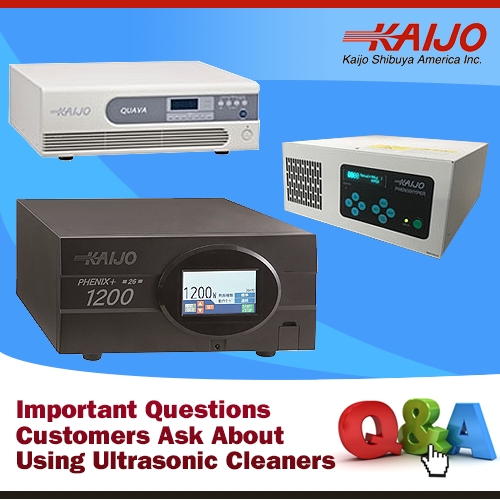Important Questions Customers Ask About Using Ultrasonic Cleaners
June 11, 2019

You should use an ultrasonic cleaner when you want quick and complete cleaning action without the use of harsh chemicals or mechanical scrubbing. To achieve the best possible performance, consider several factors to determine the most suitable ultrasonic cleaner for your application. Key cleaner characteristics include the frequency, power, type of transducer, and size of the unit. You also have to decide whether to go with a turnkey solution or purchase the components. A competent industrial ultrasonic cleaner supplier will be able to help ensure you get the cleaning performance you need.
2. How Do Ultrasonic Cleaners Work?
Ultrasonic cleaners work by generating microscopic cavitation bubbles in the cleaning solution. The ultrasonic generator produces a high-frequency electric signal that is converted to ultrasonic waves in the cleaning solution by the transducers. The bubbles form and collapse in tune with the ultrasonic waves. The collapsing bubbles deliver a powerful scrubbing action that removes dirt from the parts to be cleaned. The bubbles form wherever the cleaning solution is present, so that ultrasonic cleaning is effective inside hard-to-reach places where other methods can’t easily clean.
3. How do I Select the Right Equipment?
The best way to make sure you get the right equipment for your cleaning application is to discuss your requirements with a competent industrial ultrasonic cleaner manufacturer. Your ultrasonic cleaning partner should have extensive experience and be willing to offer advice on how to achieve your cleaning goals. Together, you should look at the physical aspects of your system, for example, whether existing tanks can be reused. Whether you always clean one type of part or have multiple uses will affect the selection of ultrasonic cleaning equipment. Your cleaning performance may be improved with the addition of heat or a mild solvent. Your ultrasonic cleaning partner can discuss the options with you and suggest the best solutions.
4. How do I Specify Equipment Size?
The parts to be cleaned have to be immersed in a cleaning solution so the ultrasonic cleaning tank has to be big enough to hold the parts. Oddly shaped parts may require a custom tank size because the tank should match the part’s shape to minimize the amount of liquid and power requirements. Small parts or parts that are easily damaged may need a parts basket to hold them inside the tank. The basket prevents them from touching the bottom or sides of the tank where vibrations may cause breakage. If multiple parts need to be cleaned, the tank should be slightly larger than the largest part. If a basket is used, the tank must be able to accommodate the basket. Your industrial ultrasonic cleaner supplier can assist you in selecting the ideal tank size.
5. Do I Need to Use a Heater?
Ultrasonic cleaning does not require the use of a heater; however, heating the cleaning solution may accelerate the cleaning process for certain applications. The scrubbing action of the microscopic cavitation bubbles produced by the ultrasonic waves removes even heavy contamination completely. This is especially true for cleaning robust parts at the lower frequencies. When the gentle cleaning action of higher frequencies is required for more delicate parts, it may take longer to remove heavy, hardened grease and oil-based contaminants. In such cases, using a heater to raise the temperature of the cleaning solution to approximately 80 degrees Celsius softens the oil and grease, making it easier to remove and speeding up the cleaning process.
6. What Does Sweep Mode Do?
When the transducers convert the electrical ultrasonic signal to sound waves, they are immersed in the cleaning solution, and their surfaces vibrate to produce the ultrasonic waves in the liquid. As the waves spread out through the cleaning tank, the parts to be cleaned interfere with the ultrasonic waves, causing spots where the waves are stronger and others where they are weaker. This pattern of interference depends on the exact frequency used. If the frequency changes slightly, the pattern of interference changes as well, and the spots of weak sound waves move. To avoid uneven cleaning due to the weak spots, sweep mode automatically varies the ultrasonic frequency slightly. The weak spots move around, and cleaning is evenly distributed.
7. Is the Use of Auto-Tuning Important?
Yes, with auto-tuning, the generator monitors and adjusts the power transmitted to the transducer array. Auto-tuning enables the system to adjust itself and maintain optimal calibration as conditions change in the process tank during operation. This means changes such as water level, temperature, and chemical changes will not affect the power level in the process tank.
8. What Ultrasonic Frequency Should I Use?
Selecting the correct ultrasonic frequency is crucial for effective cleaning. Low frequencies generate comparatively large cavitation bubbles, which deliver an intense cleaning action. Fragile parts or parts with soft surfaces may suffer damage or surface pitting at these frequencies. For high frequencies, the bubbles are smaller and less energetic, so that even delicate parts can be cleaned. Metal parts can often be cleaned at low frequencies, while semiconductor components or electronic parts with microstructures may require more gentle cleaning, which can be provided at higher frequencies. The fastest and most complete cleaning for an application is to choose the lowest frequency that will not damage the parts being cleaned.
9. What is Important about Ultrasonic Power?
While the ultrasonic frequency determines the intensity of the cleaning action, the system power influences overall cleaning performance. When the system is underpowered, cleaning action may be uneven and incomplete. The system must have sufficient power to fill the cleaning tank with ultrasonic waves. Insufficient power results in dead spots and areas with limited bubble creation, leading to poor cleaning performance. Large cleaning tanks require more power and often necessitate the use of several transducers to clean effectively, even when the parts to be cleaned are small. When a system has the power it needs, all areas of the tank, including holes, dead ends, and crevices in the parts, receive even and complete cleaning action.
10. Is the Agitation of Parts Necessary for Cleaning?
Agitation of the parts is, in general, not required, and industrial ultrasonic cleaners generally have no automatic part agitation mechanisms. If you’re cleaning many small parts in a basket, it may be beneficial to move the parts around during the cleaning process to avoid dead spots where parts interfere with the cleaning action. Kaijo’s “Water Resonance System,” (WRS) helps promote even cleaning by producing an even distribution of cavitation bubbles throughout the cleaning tank. With WRS, no parts agitation is needed.
11. What Kinds of Applications is Ultrasonic Cleaning Used In?
Ultrasonic cleaning is utilized in various industrial and commercial cleaning applications. It is especially useful in applications where quick and complete cleaning is essential. Industrial plants that can’t use hazardous substances prefer ultrasonic cleaning because it works with plain water. Environmental concerns make ultrasonic cleaning the best alternative to soaking in toxic chemicals, while disposal costs for such materials are eliminated. Saving money is also a factor for applications that require manual scrubbing or expensive cleaning chemicals because ultrasonic cleaning has low operating costs. Overall, ultrasonic cleaners are used in industries as varied as aircraft assembly and maintenance, semiconductor manufacturing, medical instrument production, the food industry, and automotive engine parts and restoration.
12. How Much Time is needed to Clean Parts?
The time required to clean parts varies according to several factors, including the type of part, the nature of the dirt, and the frequency of use. Metal parts with light contamination cleaned at a low frequency may be ready in a few minutes, whereas the average cleaning time for general-purpose cleaning is around ten to twenty minutes. Hard, baked-on grease and carbon residue, such as that found on engine parts, can be particularly difficult to remove. However, heating the cleaning solution may help in such cases. For specific organic contaminants, a mild solvent that helps dissolve the contaminating material can significantly accelerate the cleaning process. Generally, low-frequency cleaning is faster than cleaning with higher frequencies, and the system must be powerful enough to generate ultrasonic waves that fill the cleaning tank. A competent supplier of ultrasonic equipment can evaluate your cleaning applications and recommend solutions that will provide the best possible ultrasonic cleaning performance.
Selecting the Right System for Your Application
Kaijo offers expert guidance and complimentary consultation to help you select the ideal industrial ultrasonic cleaner for your specific cleaning needs. The company has extensive experience in ultrasonic technology and collaborates with customers across various industries. Once an appropriate cleaning system is selected, Kaijo can propose components from their extensive product line of ultrasonic cleaners to assemble a complete ultrasonic system.





